![]()
![]()
![]()
Use LEFT and RIGHT arrow keys to navigate between flashcards;
Use UP and DOWN arrow keys to flip the card;
H to show hint;
A reads text to speech;
118 Cards in this Set
- Front
- Back
|
Operations Management =
|
Management of the transformation Process in an effective and efficient way
|
|
|
What does efficiency do in the transformation process
|
Removes waste
|
|
|
What does effectivity do in the transformation process
|
Creates value
|
|
|
The transformation process Inputs → Transformation process → Output Give an example of a resource that could be used in each of the three stages |
Inputs: Sick patients Transformation process: Medicine Output: Healthy patient (or Healthcare) |
|
|
Name and explain the characteristics of service
|
- Intangibility services are non-physical goods - Inseparability The service cannot be seperated from the moment of consumption - Perishability services can’t be stored, hence, if not utilized, the capacity to deliver the service is wasted. - Heterogenity each service is unique, hard to standardize, and its evaluation depends on the customers subjective expectations. |
|
|
What are the three types of Strategy and their levels?
|
Corporate strategy (Level: Corporation) ↓ Business strategy (Level: Business units) ↓ Functional strategy (Finance dept., operations dept., Marketing dept., etc) |
|
|
Describe: 1. The Supply Chain 2. What happens at each stage 3. The logistical movement at specific stages |
1. Supplier → Manufacturer → Wholesaler → Retailer → Customer 2. Supplier = Purchasing Manufacturer = Producing Wholesaler and Retailer = Distribution 3. Purchasing = Inbound logistics Distribution = Outbound logistics |
|
|
What are order qualifiers? |
Order qualifiers are those things you have to do or otherwise consumers won't buy your product/service
|
|
|
What are order winners? |
Order winners are the things you do to differentiate your product/service
|
|
|
What is strategy? |
Strategy is the total pattern of decisions and actions which position the organization in its environment and are intended to achieve its long term goals.
|
|
|
Identify and elaborate on the four types of strategy
|
1) Focus Solid understanding of customer value created 2) Differentiation Achieving sustainable competitive advantage 3) Allignment Create a constant pattern in decisions (throughout the organization and over time) 4) Priorities Shows where to invest money/efforts and how to make trade-offs |
|
|
What does operational strategy depend on?
|
- Resources - Processes - (Core) Competenties |
|
|
What are the five key performance measures for operations strategy?
|
1) Cost 2) Quality 3) Speed 4) Dependability 5) Flexability |
|
|
Name two examples for each of the five key performance measures for operational strategy
|
1) Cost ► Utilization: used time / available time ► Productivity: items produced / labor usage ► Inventory turns: items sold / average inventory 2) Quality ► % defective produced (goal: Zero defects) ► # of complaints 3) Speed ► Order lead time ► Time-to-market of new product ► Time to volume 4) Dependability ► Fill rate ► Lost sales ► % deliveries in time 5) Flexability ► Absorb significant fluctuations in Demand ► Change-over times ► # SKUs (level of customization) ► Adaptability to new technologies |
|
|
Name five shapes which are used in a Process Flow Diagram and their meaning
|
1) Circle: Start or end 2) Rectangle: Value adding activity 3) Triangle: Inventory/Queue 4) Diamond: Decision which branches yes/no 5) Flat line: Transport/ Hand-off |
|
|
Graph the operational efficiency frontier
|
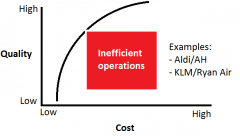
Make sure you are always on the line! Otherwise you have an inefficient operation
|
|

What could help to make sure you are on the line of the operational efficiency frontier?
|
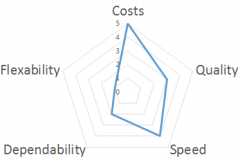
Plotting a polar diagram with the five key performance measures |
|
|
What is a process?
|
A group of activities that add value for a customer
|
|
|
Define theoretical throughput time
|
Total time a job spends in the process |
|
|
Define actual throughput time
|
The total time a job spends in the process + the waiting time. E.g.: The theoretical throughput time + the waiting time |
|
|
What is the design capacity?
|
The theoretical maximum job capacity
|
|
|
What is the effective capacity?
|
The design capacity - planned down time |
|
|
What is the realized actual capacity?
|
The effective capacity - the unplanned down time
|
|
|
How do you calculate the utilization?
|
Utilization = Actual Ouput / Design Capacity
|
|
|
How do you calculate the efficiency?
|
Efficiency = Active Output / Effective Capacity
|
|
|
What does set-up time consist of?
|
Clean-up time + Start-up time
|
|
|
What is the difference between the internal arrival time (IAT) and the arrival rate?
|
The internal arrival time is the time between two jobs whereas the arrival rate is the average amount of jobs per time unit (e.g. per hour)
|
|

Which formula is this?
|
Little's Law
|
|

Which formula is this?
|
Little's Law in case of batches
|
|
|
What is the throughput rate? (also called the flow rate) |
the system's maximal number of jobs per time unit
|
|
|
What is the bottleneck?
|
The bottleneck is either (1) the demand on a system, or (2) the activity with the lowest capacity
|
|
|
What is cycle time
|
The time the system takes in between producing two jobs
|
|
|
How do you calculate the cost of direct labour?
|
Cost of direct labour = total wages per time / throughput time |
|
|
How do you calculate the actual added value?
|
Cost of direct labour (x) throughput efficiency
|
|
|
What is idle time?
|
The sum of bottleneck time - time of other activities
|
|
|
What is throughput efficiency?
|
Throughput time / (Throughput time + Idle time)
|
|
|
What does Wq stand for?
|
Average queing time
|
|
|
What does variability always do to performance?
|
Decreased
|
|
|
Variability always decreased performance. How could this be solved? |
- Manage demand - Inventory/capacity - Mix/volume/time - Workload/Utilization |
|
|
Draw the process matrix for production
|
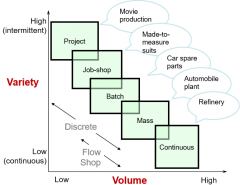
Project Job-shop Batch Mass Continues |
|
|
Draw the process matrix for service
|
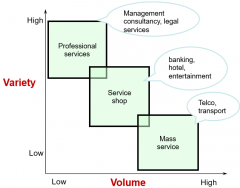
Professional Services Service Shop Mass Service |
|
|
Draw the lay-out matrix
|
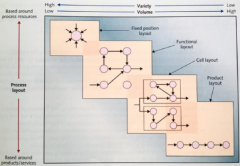
Fixed position lay-out Functional lay-out Cell lay-out Product lay-out |
|
|
Identify and describe the four basic lay-out types
|
● Fixed position layout ► Product remains on one position and production means are brought to the product ● Functional layout – Work center ► Production means are grouped according to function / specialization ● Group layout – Manufacturing cell ► Production means are grouped to optimize movement of materials ● Product layout ► Production means are grouped following the steps of the production process |
|
|
Name the ordering types that belong to the the Customer Order Decoupling Point and provide an example
|
- Make-to-stock (Apple) - Assemble-to-order (Dell) - Make-to-order (IBM) - Purchase-to-order (D-Wave) |
|
|
Describe techniques of moving back (or postponement) (CODP) |
● Moving Backward, or Postponement ► Techniques → Modular Production → Distributed production (e.g. 3D printing) |
|
|
What are some of the pros and cons of moving back (or postponement)? (CODP) |
● Moving Backward, or Postponement ► Pros and Cons → Increased Customization → Increased Order Lead times → Reduced Inventory of end-products |
|
|
Describe techniques of moving forward (CODP)
|
► Techniques → Interchangeable parts → Standardization (products/parts) → Pliable staff (crossed-trained staff) |
|
|
What are some of the pros and cons of moving forward?(CODP)
|
► Pros and Cons → Reduced Customization → Reduced Order Lead times → Increased Inventory of end-products |
|
|
Define postponement?
What is the current trend in postponement? |
Postponement = delaying further investments in a product or service until the last possible moment to minimize risk and maximize possible benefits. Trend: A shift away from postponement (less SKU's, longer lifecycles) |
|
|
What are the two types of product planning?
|
1) Capacity planning (1 - 5 years) 2) Aggregate planning (6 - 12 months) |
|
|
Name the four aggregate planning strategies?
|
- Provide - Chase - Level - Mixed |
|

Identify the four planning strategies
|
Green: Provide Black: Level Purple: Chase Dotted: Mixed |
|
|
Name an example, pros and cons of 'Provide planning'
|
+ Customer service (Speed advantage) - High costs E.g. Utilities, hospital |
|
|
Name pros and cons of 'Level planning' and elaborate on ways to counter its negative effects.
|
+ Easy to plan + Low costs - Pour customer service How to solve: - Use inventory - Subcontracting - Backordering - Counter seasonality |
|
|
Name pros and cons of 'Chase planning' and elaborate on ways to counter its negative effects.
|
+ Customer satisfaction - Hard to plan / Manage How: - Flexibility of labour - Mix/Volume flexibility |
|
|
Why is demand management especially important in service industries?
|
Service companies do not have an 'inventory' of their service which they can use to smooth out the demand (Perishability) |
|
|
Overall Equipment Effectiveness (OEE) = a x p x q Calculate a (availability loss) |
Total Operating Time / Available Operating Time
|
|
|
Overall Equipment Effectiveness (OEE) = a x p x qCalculate p (speed or performance loss)
|
Net Operating Time / Total Operating Time
|
|
|
Overall Equipment Effectiveness (OEE) = a x p x qCalculate q (quality loss)
|
Valuable operating time / Net operating time
|
|
|
TIP to remember regarding OEE
|
a x p x q = on alphabetical order All three formulas read: TA NT VN |
|
|
Define available operating time
|
The total available operating time
|
|
|
Define total operating time
|
Available operating time - availability losses
|
|
|
Define net operating time
|
Total operating time - speed (performance) losses
|
|
|
Define Valuable operating time
|
Net operating time - quality losses
|
|
|
What are the components of planning through optimization?
|
1) Constant Values - Given data 2) Decision variables - Quantities under own control 3) Objective function - What to maximize or minimize (E.g. maximize profit or minimize costs) 4) Constraints - Restrictions on our choices of the decision variable |
|
|
What are the four stages in the four stage model of contribution?
|
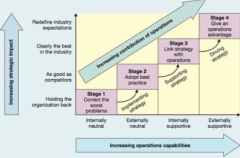
|
|
|
What are SKUs?
|
Stock Keeping Units, the smallest units that can be sold from stock or purchased.
|
|
|
Identify and elaborate on the motives for holding inventory.
|
1) Transformation motive (cycle stock) 2) Precautionairy motive (safety stock) 3) Speculative motive 4) Decoupling motive
1) Order large / produce in batches Fixed cost can be reduced 2) Hedge againt uncertainty 3) Anticipation inventory E.g. a price change or labour strikes 4) ... |
|
|
Identify and elaborate on the motives for not holding inventory.
|
1) Cost 2) Obsolescence 3) Delay in the process 4) Inventory hides problems
1) Fixed (facility), variable (handling), and Opportunity cost 2) Perishable, fashion, short product life cycle 3) Loss of speed/quality 4) ... |
|
|
What is the objective when you determine how much to order (Q)?
|
The objective is to minimize relevant cost.
|
|
|
What costs are relevant to ordering?
|
- Holding Cost (Ch) - Ordering Cost (Co) |
|
|
What is the formula for Ch?
|
Holding Cost per year = (Average Inventory Level) · (Inv. holding cost per unit per year) = (Q/2) · CH |
|
|
What is the formula for Co?
|
(Number of Orders per year) · (Cost per order) = (D/Q) CO |
|
|
What is the formula for minimizing TV (Q)?
|
Minimize TV(Q) = ½ (Q CH) + (D CO)/Q Use the EOQ for Q Make sure everything is related to annuals! |
|
|
How does one determine when to order? (s)
|
s = D·L s = equal to the demand during the lead time |
|
|
What can be said about the sensitivity of EOQ?
|
TV is insensitive to small changes around the optimal point.
|
|
|
EOQ has several underlying assumptions. What are these?
|
- That demand is deterministic (vs. stochastic) - That set-up cost are fixed (vs. variable) - That a single product is produced (vs. multiple) |
|
|
What does the formula look like for determining the Q with the minimal TV when production is done in batch sizes?
|

Use the EOQ for Q Make sure everything is related to annuals! |
|
|
In a situation with a stochastic demand, how is the Q determined that minimizes TV?
|

= TV (Q)
|
|
|
How is the re-order level determined in a situation with stochastic demand?
|
s = µLTD + Safety stock
|
|
|
What types of inventory systems exist?
|

● “How much to order?” ► Fixed quantity Q ► Order up-to level S
● “When to order” ► Fixed points in time R (periodic review) ► At an inventory position s (continuous review) |
|
|
How could you reduce the stocks at each of the different motives: 1) Transaction motive 2) Precautionary motive 3) Speculative motive 4) Decoupling motive |
1) Reduce set-up time, ordering cost 2) Reduce uncertainty - preventive maintenance - better insights in customer situations - more information towards suppliers 3) Chase demand rather then level demand 4) Coördination, Integration, Partnership |
|
|
What is the academic definition of Lean?
|
A social-technical system to eliminate waste by minimizing variability
|
|
|
What is the managerial definition of Lean?
|
Maximizing customer value by eliminating waste
|
|
|
Draw the Lean House. Toyota Production System (TPS) |
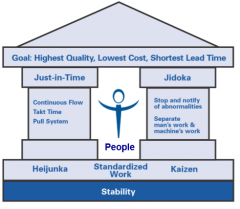
|
|
|
Name several principles of Lean management.
|
1) Just-in-time production (JIT) 2) Jidoka: Highlight/visualize problems 3) People management: Delegating, respect, horizontal 4) Kaizen: continous improvement (PDCA) 5) Value stream mapping 6) 5S: Organizing the workplace Sort-Stabalize-Shine-Standardize-Sustain 7) 5 whys: Asking why five times 8) Heijunka (leveled scheduling) 9) Poke-Yoke 10) Kanban: produce only when there is demand 11) Gemba: Managers on the floor, respect |
|
|
What is MRP
|
Materials Requirement Planning |
|
|
What is an MPS and what does it do? |
MPS: Master Producion Schedule It determines the demand for parts |
|
|
Draw the process of closed loop resource planning
|
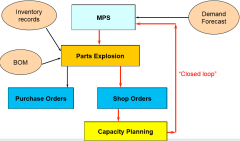
|
|
|
What is ERP?
|
Extended Resource Planning: Resource planning across companies |
|
|
What are the three stages of planning and control>
|
1) Planning, how much to do? 2) Sequencing & Scheduling, in what order and when to do? 3) Monitoring & Control |
|
|
What are the bases on which Sequencing & Scheduling can be determined?
|
- FIFO - LIFO - LOT (longest operating time) - SOT (shortest operating time) - Customer priority - Due dates |
|
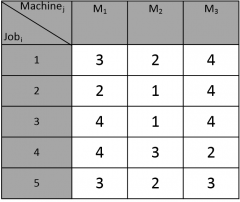
Draw a Gantt-chart based on these figures
|
|
|
|
What is pull production Always?
|
- Demand driven - Based on actual demand |
|
|
What is push production Always?
|
- Operations driven - Based on forecasted demand |
|
|
What is an important advantage of pull production?
|
- Low WIP |
|
|
What is DRUM-BUFFER-ROPE?
|
Drum: Sets the pace Rope: Order releases based on the bottleneck Buffer: having a longer rope |
|
|
What are the steps in the theory of constraints?
|
1. Identify the bottleneck 2. Exploit the bottleneck 3. Subordinate everything to the bottleneck 4. Elevate the bottleneck 5. If bottleneck eliminated, return to step 1 |
|
|
What are the 8 dimensions of quality?
|
PFR CDSAP 1. Performance 2. Features 3. Reliability 4. Conformance 5. Durability 6. Servicability 7. Aesthetics 8. Perceived Quality |
|
|
What are the sources of waste?
|
DOWNTIME 1. Defects 2. Overproductions 3. Waiting 4. Non-used talent 5. Transport 6. Inventory 7. Movement 8. Excess processing |
|
|
What are the sources of inefficiency?
|
1. Waste 2. Variability 3. Inflexibility |
|
|
What is quality of design?
|
Subjective
|
|
|
What is quality of conformance?
|
Conformance = conformance to the specifications Objective |
|
|
What is the expectancy disconformation theory?
|
Perceived performance < Expectations = Negative disconformation Perceived performance > Expectations = Positive disconformation |
|
|
What does the Service Quality Model state?
|
GAP Model / ServQual model Customer satisfaction = Experienced quality - Expected quality |
|
|
Name and elaborate on an important way to determine the cost of quality.
|
PAF: Prevention cost - Appraisal cost - Failure cost Unavoidable Avoidable |
|
|
What is SPC?
|
Statistical Process Control (SPC): Seeking sources of non-natural variation (which indicates a special cause) by using control charts. |
|
|
When is a system out of control according to SPC?
|
When the control charts show non-random behaviour
|
|
|
Calculate the UCL, CL, and LCL for an x-bar chart
|
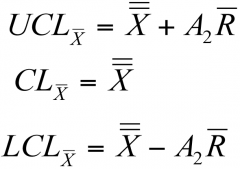
|
|
|
Calculate the UCL, CL, and LCL for an r-chart
|
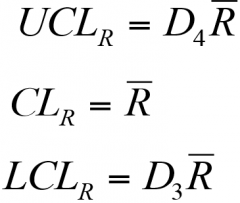
|
|
|
Fill in: The process capability ratio (Cp), for which the formula will be given, should be above ... for it to be good. When it is below ... it is bad. Also, when is it used? |
1 It is used when CL and SL are the same |
|
|
The process capability index (Cpk), for which the formula will be given, should be above ... for it to be good. When it is below ... it is bad. Also, when is it used? |
1 It is used when CL and SL are not the same |
|
|
What is the objective of 6 sigma?
|
To minimize variability in the process
|
|
|
What are some methods which can be applied to find root causes of problems?
|
- Ishikawa (fish bone) - Pareto (80% of the problems are caused by 20% of the causes) |
|
|
What does a quality assurance system do?
|
- It describes standards for a quality system - The quality system will be externally audited - A certificate is given for a limited time (E.g. ISO) |
|
|
What are the principles of TQM?
|
1. Everyone in the organization is responsible for quality 2. Each process has a (internal) customer 3. Entire organization is focussed on quality (strategy, design, etc.) |
|
|
What could a manager do when implementing TQM?
|
- Communicating and providing data - Setting a strategy - Setting guidelines - Motivate and inspire employees |
|
|
What are the components of TQM?
|
1. Everything is customer focussed 2. Empowerment 3. Quality at the source (cost saving benefit) 4. Ongoing improvement (Kaizen - PDCA) 5. Management based on facts |

